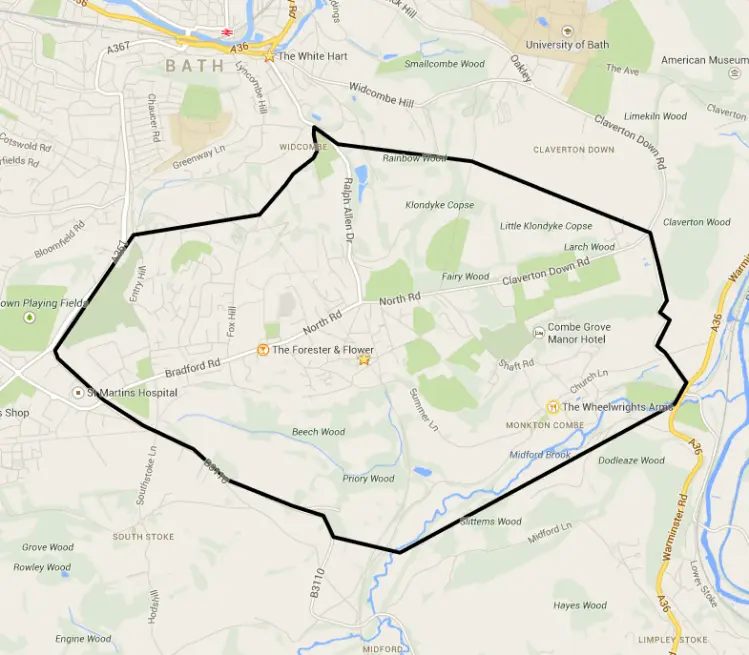Listed Buildings
This is, obviously, a list of (hopefully) all the listed buildings on Combe Down and in Midford and Monkton Combe – the area that I have taken as Combe Down and shown on the map.
Essentially, is the hill itself. Almost all the area has, at one time or another or by one authority or another, been regarded as a part of Combe Down.
I have divided this into 16 areas – shown on the tabs – as follows:
- Prior Park
- North Road
- The Avenue
- Church Road
- Belmont Road
- Summer Lane
- Combe Road
- Bradford Road
- Entry Hill
- Perrymead
- Midford Castle
- Tucking Mill
- Monkton Combe
- Brassknocker Hill
- Combe Grove Manor
- Shaft Road
For each building or monument I have tried to give:
- A link to Google maps
- A link to the Historic England listing
- A link to a photograph of the building or monument via a Pinterest board (Listed buildings and monuments on Combe Down and in Midford and Monkton Combe) which is also embedded below, so that it’s easy to browse.
- A brief summary of the building or monument
Listed buildings and stunning architecture
The principles of selection for listing buildings and deciding whether a building is of special architectural or historic interest are set out under the Planning (Listed Buildings and Conservation Areas) Act 1990.
It imposes a duty on the Secretary of State for the Department for Culture, Media and Sport to compile or approve a list or lists of buildings of special architectural or historic interest as a guide to the planning authorities when carrying out their planning functions.
The planning system is supposed to be designed to regulate the development and use of land in the public’s interest.
Buildings on the list are graded to reflect their relative architectural and historic interest but buildings of historic interest may justify a higher grading than would otherwise be appropriate.
- Grade I buildings are of exceptional interest
- Grade II* buildings are particularly important buildings of more than special interest
- Grade II buildings are of special interest, warranting every effort to preserve them
Statutory Criteria
There are statutory criteria that the Secretary of State uses in assessing whether a building is of special interest and therefore should be added to the statutory list. These are:
Architectural interest
To be of special architectural interest a building must be of importance in its architectural design, decoration or craftsmanship; special interest may also apply to nationally important examples of particular building types and techniques (e.g. buildings displaying technological innovation or virtuosity) and significant plan forms.
Historic interest
To be of special historic interest a building must illustrate important aspects of the nation’s social, economic, cultural, or military history and/or have close historical associations with nationally important people. There should normally be some quality of interest in the physical fabric of the building itself to justify the statutory protection afforded by listing.
General Principles
There are also general principles that the Secretary of State uses in assessing whether a building should be added to the statutory list. These are:
Age and rarity
The older a building is, and the fewer the surviving examples of its kind, the more likely it is to have special interest. A chronology is used as a guide to assessment; the dates are indications of likely periods of interest and are not absolute. The relevance of age and rarity will vary according to the particular type of building because for some types, dates other than those given are significant. However, the general principles are:
- that before 1700, all buildings that contain a significant proportion of their original fabric are listed
- from 1700 to 1840, most buildings are listed
- after 1840, because of the greatly increased number of buildings erected and the much larger numbers that have survived, progressively greater selection is necessary
- particularly careful selection is required for buildings from the period after 1945
- buildings of less than 30 years old are normally listed only if they are of outstanding quality and under threat
Aesthetic merits
The appearance of a building – both its intrinsic architectural merit and any group value – is a key consideration in judging listing proposals, but the special interest of a building will not always be reflected in obvious external visual quality.
Buildings that are important for reasons of technological innovation, or as illustrating particular aspects of social or economic history, may have little external visual quality.
Selectivity
Where a building qualifies for listing primarily on the strength of its special architectural interest, the fact that there are other buildings of similar quality elsewhere is not likely to be a major consideration. However, a building may be listed primarily because it represents a particular historical type in order to ensure that examples of such a type are preserved.
Listing in these circumstances is largely a comparative exercise and needs to be selective where a substantial number of buildings of a similar type and quality survive. In such cases, the policy is to list only the most representative or most significant examples of the type.
National interest
The emphasis is to establish consistency of selection to ensure that not only are all buildings of strong intrinsic architectural interest included on the list, but also the most significant or distinctive regional buildings that together make a major contribution to the national historic stock.
For instance, the best examples of local vernacular buildings will normally be listed because together they illustrate the importance of distinctive local and regional traditions. Similarly, for example, some buildings will be listed because they represent a nationally important but localised industry, such as shoemaking in Northamptonshire or cotton production in Lancashire.
State of repair
The state of repair of a building is not a relevant consideration when deciding whether a building meets the test of special interest. The policy is to list a building which has been assessed as meeting the statutory criteria, irrespective of its state of repair.
In addition to listed buildings English Heritage compiles registers of parks and gardens of special historic interest, and of historic battlefields. The designation of conservation areas is the responsibility of local planning authorities.
Listed Buildings Images
Listed buildings on Combe Down
Prior Park
Prior Park area
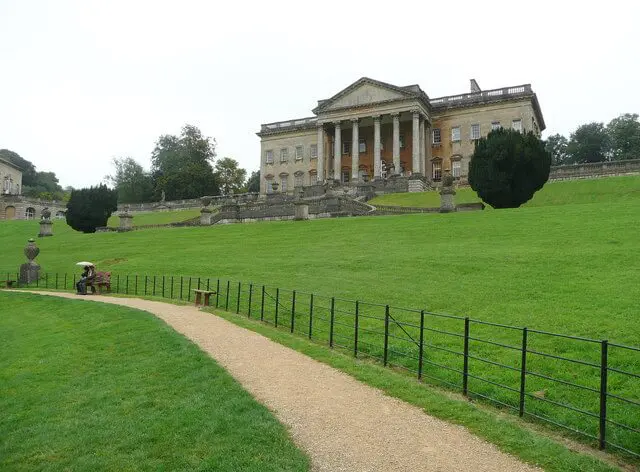
-
Gate piers at South end of Ralph Allen Drive. List entry number: 1394607. Link to Pinterest. Pair of large ashlar gate piers c 1740, by John Wood the Elder, set to each side of the drive
-
Top Lodge, Ralph Allen Drive, Bath, BA2 5AG. List entry number: 1394610. Link to Pinterest. Stone built, 3 storey lodge designed by Wood the Elder.
-
Cricket Pavilion c.100m South of Prior Park Mansion. List entry number: 1405946. Apparently the relocated plunge bath of Ralph Allen, which originally stood below the house on the North side. The interior is well preserved but retains nothing below ground and the original plan and function of the bath is uncertain.
-
Prior Park Gymnasium. List entry number: 1394469. Link to Pinterest. c. 1830 – 40, structure probably associated with the foundation of Prior Park College by Bishop Baines, apparently built as a gymnasium with a five’s court forming an ashlar walled courtyard.
-
Prior Park Mansion (now Prior Park College). List entry number: 1394453. Link to Pinterest. Built for Ralph Allen by John Wood, Elder, as advertisement for his local stone between 1735 – 43.
-
Church of St. Paul and West wing. List entry number: 1394459. Link to Pinterest. Classic Corinthian order 1844 by Scoles and Son situated in one of the 2 large wings attached to the mansion which were by John Pinch c. 1830, and H E Goodridge in Neo-Grec style c. 1836.
-
Gate piers and gate to main entrance. List entry number: 1394605. Link to Pinterest. Pair of rusticated stone piers surmounted by entablatures and large ornamental vases.
-
Porter’s Lodge. List entry number: 1394608. Link to Pinterest. Ashlar lodge, probably c. 1829 – 1836 as part of improvements by H E Goodridge for Bishop Baines.
-
East wing and porte cochere. List entry number: 1394460. Link to Pinterest. Ashlar former service wing to house. c. 1750, designer possibly Richard Jones, Ralph Allen’s clerk of works at Prior Park, reconstructed and heightened c. 1830, modified 20th century.
-
Bridge to pool approx 50m North of the Church of St Paul. List entry number: 1394450. Link to Pinterest. Ashlar ornamental bridge with pool. c. 1740 – 1750, possibly by Richard Jones, Ralph Allen’s clerk of works at Prior Park.
-
Grotto. List entry number: 1394467. Link to Pinterest. Tufa or sponge stone remains of grotto c. 1740, sometimes known as Pope’s Grotto, but probably executed by Richard Jones, Ralph Allen’s clerk of works at Prior Park.
-
Garden archway. List entry number: 1394457. Link to Pinterest. Heavy round headed Palladian archway with deep coarse vermiculation, ashlar impost bands and massive ashlar keystone.
-
Gate piers and gates to drive. List entry number: 1394606. Link to Pinterest. Pair of stone gate posts with ornamental carved finials.
-
Ice house. List entry number: 1394461. Link to Pinterest. Circular, stone-lined with domed stone roof.
-
The Priory. List entry number: 1394465. Link to Pinterest. Before 1742 as the plan and elevation appear on estate map of that year. Could very well be by John Wood the Elder possibly continued by the Clerk of Works Richard Jones. Unusual early example of use of Gothic detail – there was a monastic building on this site or near it – 2 storeys irregularly coursed rubble.
-
Palladian Bridge. List entry number: 1394463. Link to Pinterest. Copy of one at Wilton built by Robert Morris in 1736. Built 1750 – 60.
-
Fishponds Cottage, Church Lane, Bath, BA2 6BD. List entry number: 1395668. Early 19th century detached ashlar house.
-
Rock Gate, (or Chinese gateway) with retaining wall, Ralph Allen Drive. List entry number: 1394609. Ashlar and rubble, sponge stone, retaining wall with gateway and softwood gate c. 1750, restored 19th and 20th centuries.
-
Pope’s Walk bridge. List entry number: 1394397. Link to Pinterest. Rubble, some tufa, cut stone to vaulting Footbridge over footpath, mid 18th century.
-
Foxhill Grove Farm, Perrymead, Combe Down, Bath,BA2 5BA. List entry number: 1395788. Ashlar detached villa c. 1830 with late 19th century additions and 20th century alterations.
North Road
North Road area

-
Telephone box at junction with The Avenue, North Road. List entry number: 1395853. Standard K6 or `Jubilee’ cast iron telephone kiosk c. 1935 by Sir Giles Gilbert Scott.
-
100 to 104 North Road, Combe Down, Bath, BA2 5DJ. List entry number: 1395879. Link to Pinterest. Early 19th century row of 2 storey rangework cottages.
-
106 North Road, Combe Down, Bath, BA2 5DJ. List entry number: 1395881. Link to Pinterest. Part of early 19th century row of 2 storey rangework cottages
-
Edward House, 106a North Road, Combe Down, Bath, BA2 5DJ. List entry number: 1395883. Link to Pinterest. c. 1830 and originally 2 storeys and heightened by one storey. Front at right angles to road. Rangework to ground and 1st floors, ashlar 2nd floors.
-
Mannings Works, Oxford Place, Combe Down, Bath, BA2 5HD. List entry number: 1394222. Link to Pinterest. Early 19th century block of 3 two storey rangework cottages and workshop.
-
1 to 3 Oxford Place, Combe Down, Bath, BA 2 5HD. List entry number: 1394216. Link to Pinterest. Early 19th century block of 3 two storey rangework cottages and workshop.
-
Tyning House, 4 Oxford Place, Combe Down, Bath BA2 5HD. List entry number: 1394221. Link to Pinterest. Early 19th century 2 storey ashlar house.
-
Victoria Cottage, Rose Terrace, Combe Down, Bath, BA2 5EW, IoE Number 446823. Link to Pinterest. (Delisted 2010). c. 1830 – 40 unusual small cottage with 1 storey and attic in ashlar; square plan with pyramidal slate roof.
-
124 North Road, Combe Down, Bath, BA2 5DL. List entry number: 1395885. Link to Pinterest. Part of early 19th century 2 storey ashlar row.
-
126 and 128 North Road, Combe Down, Bath, BA2 5DL. List entry number: 1395887. Link to Pinterest. Part of early 19th century 2 storey ashlar row.
-
130 and 132 North Road, Combe Down, Bath, BA2 5DL. List entry number: 1395888. Link to Pinterest. c. 1830 – 50 pair of 2 storey ashlar houses.
-
134 and 136 North Road, Combe Down, Bath, BA2 5DL. List entry number: 1395890. Link to Pinterest. c. 1830 – 50 pair of 2 storey ashlar houses.
-
138 North Road, Combe Down, Bath, BA2 5DL. List entry number: 1395892. Link to Pinterest. c. 1840 2 storey ashlar house.
-
140 and 140a North Road, Combe Down, Bath, BA2 5DL. List entry number: 1395893. Link to Pinterest. c. 1830 small L plan 2 storey ashlar house with right hand part set back in line with rest of terrace.
-
Norfolk House, 142 North Road, Combe Down, Bath, BA2 5DL. List entry number: 1395895. Link to Pinterest. Early 19th century 2 storey irregular coursed stone house.
-
Airedale Cottage, 144 North Road, Combe Down, Bath, BA2 5DL. List entry number: 1395897. Link to Pinterest. Early to mid 19th century 2 storey coursed rubble house.
-
146 to 152 North Road, Combe Down, Bath, BA2 5DL. List entry number: 1395899. Link to Pinterest. Two c. 1840 – 50 pairs of 2 storey ashlar small houses.
-
154 and 156 North Road, Combe Down, Bath, BA2 5DL. List entry number: 1395900. Link to Pinterest. c. 1840 ashlar faced houses with plat band. No 154 2 storeys. No 156 heightened by one storey and mansard attic and with 4 storey square tower to left.
-
158, 160 and 162 North Road, Combe Down, Bath, BA2 5DL. List entry number: 1395901. Link to Pinterest. c. 1840 – 50 row of three 2 storey ashlar houses.
-
Rosemount, 13 Gladstone Road, Combe Down, Bath BA2 5HJ. List entry number: 1395925. Mid 19th century detached ashlar house.
The Avenue
The Avenue area

-
The Hadley Arms including outbuildings to rear, North Road, Bath, BA2 5DH. List entry number: 1395916. Link to Pinterest. c. 1840 – 50 2 storey ashlar building built as a pub.
-
Coach house to West of Hadley Arms, North Road, Bath, BA2 5DH. List entry number: 1395914. Squared and dressed block detached small house possibly mid 18th century.
-
Combe Down House, (Combe Down Surgery), The Avenue, Combe Down, Bath, BA2 5EG. List entry number: 1406234. Compact two storey mid 19th century ashlar villa.
-
Park House, 1 Park Place and Arclane 2 Park Place, The Avenue, Combe Down, Bath, BA2 5ED. List entry number: 1395341. Link to Pinterest. c. 1820 – 30 pair of 2 storey ashlar faced houses,
-
Graham House, 3 Park Place, The Avenue, Combe Down, Bath, BA2 5EH. List entry number: 1395343. Link to Pinterest. c. 1820 3 storey ashlar faced house.
-
Park Villa, The Avenue, Combe Down, Bath, BA2 5EF. List entry number: 1406356. An early 19th century villa, extended and altered in the later 19th and 20th century
-
2 Avenue Place, Combe Down, Bath, BA2 5EE. List entry number: 1394154. Link to Pinterest. One of the earliest developments on Combe Down, dating from the 1720/30s. Formerly part of the Carriage Inn, which took its name from the stone-bearing wagons used in the local quarries.
-
3 Avenue Place, Combe Down, Bath, BA2 5EE. List entry number: 1394155. Link to Pinterest. One of the earliest developments on Combe Down, dating from the 1720/30s. Formerly part of the Carriage Inn, which took its name from the stone-bearing wagons used in the local quarries.
-
4 Avenue Place, Combe Down, Bath, BA2 5EE. List entry number: 1394158. Link to Pinterest. One of the earliest developments on Combe Down, dating from the 1720/30s. Formerly part of the Carriage Inn, which took its name from the stone-bearing wagons used in the local quarries.
-
5 Avenue Place, Combe Down, Bath, BA2 5EE. List entry number: 1394160. Link to Pinterest. Small workman’s cottage built on as an extension to number 4.
-
Isabella House, The Avenue, Combe Down, Bath, BA2 5EH. List entry number: 1395337. Link to Pinterest. Dated 1887, neo-Georgian 3 storey ashlar front.
Church Road
Church Road area

-
Old Post Office, 78 Church Road, Combe Down, Bath, BA2 5JQ. List entry number: 1406073. Early 19th century 2 storey ashlar and dressed stone former cottages.
-
71 to 79 Church Road (Isabella Place), Combe Down, Bath, BA2 5JY . List entry number: 1395677. Link to Pinterest. 1805 terrace of uniform 3 storey houses, ashlar faced.
-
1 – 3 De Montalt Place (Bank), Combe Down, Bath, Bath and North East Somerset BA2 5HT. List entry number: 1394017. Link to Pinterest. Late 19th century restrained neo Georgian 3 storey ashlar design built as bank.
-
Lonsdale, 81 Church Road, Combe Down, Bath, BA2 5JJ. List entry number: 1395680. c. 1900 ashlar house, now the vicarage.
-
83 to 101 Church Road (De Montalt Place), Combe Down, Bath, BA2 5JJ. List entry number: 1395682. Link to Pinterest. Part of the original development on Combe Down. c. 1730s 2 storey ashlar terrace, part possibly of John Wood’s “Higher Town” and built by the masons associated with the quarries.
-
Church Of The Holy Trinity, Church Road, Combe Down, Bath, BA2 5JJ. List entry number: 1394011. Link to Pinterest. 1835 Gothic Revival church by H E Goodridge. Octagonal Western tower with spire; aisles and chancel added in late 19th century.
-
Claremont House, 109 Church Road, Combe Down, Bath, BA2 5JJ. List entry number: 1395684. Link to Pinterest. About 1805 3 storey ashlar faced house originally of 2 storeys.
-
Union Chapel Church Road, Combe Down, Bath, BA2 5JJ. List entry number: 1394024. Link to Pinterest. 1815 ashlar Union chapel with later 19th century alterations and additions.
-
Piers, gate and railings to and The Old Vicarage, 110 Church Road, Combe Down, Bath, BA2 5JJ. List entry number: 1394023 and List entry number: 1394655. Link to Pinterest. c. 1840 asymmetric 2 storey ashlar house in substantial grounds with bold exaggerated Jacobethan details. By H E Goodridge.
-
113 to 117 Church Road, Combe Down, Bath, BA2 5JJ with boundary walls and piers. List entry number: 1395686. Link to Pinterest. Row of 3 (originally 4) ashlar faced houses. Originally of 2 storeys number 113 has been increased to 3 storeys and 115 has been increased to 4 storeys.
-
Hope Cote Lodge, 127 Church Road, Combe Down, Bath, BA2 5JJ. List entry number: 1394016. Link to Pinterest. c. 1805 2 storeys ashlar terrace converted later in 19th century to one dwelling with French mansard slate roof and segmental pedimented dormers.
-
Combe Down old junior school with piers and railings, Church Road, Combe Down, Bath, BA2 5JL. List entry number: 1394014. Link to Pinterest. Originally Combe Down Junior School built from 1837, enlarged in 1887 and c 1900. Ashlar. The original building, the West front range, was the school master’s house on the ground and first floors with the school room above on the second floor. In 1887 a large single storey schoolroom wing was built at the back (East) and c. 1900 a further school room was built on the South side of the rear wing.
-
Combe Lodge, 139 Church Road, Combe Down, Bath, BA2 5JL. List entry number: 1395689. Link to Pinterest. Mid 19th century house of 2 storeys and basement, ashlar faced with 4 window front.
-
Welford House, 141 Church Road, Combe Down, Bath, BA2 5JL. List entry number: 1393989. Link to Pinterest. c.1840 – 50, ashlar villa of 2 storeys.
-
Brow Lodge, Church Road, Combe Down, Bath, BA2 5JL. List entry number: 1394009. Link to Pinterest. Single storey Gothicised lodge at entrance to the forecourt of the Brow.
-
The Brow, Church Road, Combe Down, Bath, BA2 5JL. List entry number: 1394018. Link to Pinterest. Substantial 1830 – 35, 2 storey ashlar house set in spacious grounds.
-
Erin Cottage, Tyning Road, Combe Down, Bath, BA2 5ER. List entry number: 1395408. Mid 19th century ashlar detached house.
-
Scott House, 147 Church Road, Combe Down, Bath, BA2 5JN. List entry number: 1393998. Link to Pinterest. c.1840 – 50, 2 storey ashlar house.
-
Southfield, 149 Church Road, Combe Down, Bath, BA2 5JN. List entry number: 1394001. Link to Pinterest. c. 1840 – 50, villa similar to No 147.
-
The Garth, 151 Church Road, Combe Down, Bath, BA2 5JN. List entry number: 1394002. Link to Pinterest. c. 1850 – 60, 2 storey ashlar faced house.
-
Charlton House, 153 – 155 Church Road, Combe Down, Bath, BA2 5JN. List entry number: 1394004. Link to Pinterest. c. 1850 – 60, 2 storey ashlar faced house.
-
Overland, 157 Church Road, Combe Down, Bath, BA2 5JN. List entry number: 1394007. Link to Pinterest. c. 1870 – 75, 2 storey ashlar faced house.
-
Glenburnie, 159 Church Road, Combe Down, Bath, BA2 5JN. List entry number: 1394008. Link to Pinterest. c. 1855 – 60, 3 storey ashlar faced villa.
Belmont Road
Belmont Road area

-
Gate piers, gates and boundary walls to and Ashlands, Belmont Road, Combe Down, Bath, BA2 5JR. List entry number: 1394517 and List entry number: 1394525. Link to Pinterest. c. 1850 Italianate 2 storey ashlar villa
-
Boundary walls and piers to, and Belmont House, Belmont Road, Combe Down, Bath, BA2 5JR. List entry number: 1394529 and List entry number: 1394527. Link to Pinterest. c. 1850 ashlar villa with slight Italianate details.
-
Combe Ridge, Belmont Road, Combe Down, Bath, BA2 5JR. List entry number: 1394530. Link to Pinterest. c. 1850 ashlar villa with slight Italianate details.
-
Vale View House, Belmont Road, Combe Down, Bath, BA2 5JR. List entry number: 1394532. Link to Pinterest. c. 1850 ashlar faced villa with thin Tudor details.
-
St. Christopher, Belmont Road, Combe Down, Bath, BA2 5JR. List entry number: 1394531. Link to Pinterest. c. 1850 ashlar villa with Italianate details.
-
Boundary walls and piers to, and West Brow, Belmont Road, Combe Down, Bath, BA2 5JR. List entry number: 1394536 and List entry number: 1394533. Link to Pinterest. c. 1850 ashlar villa.
Summer Lane
Summer Lane area
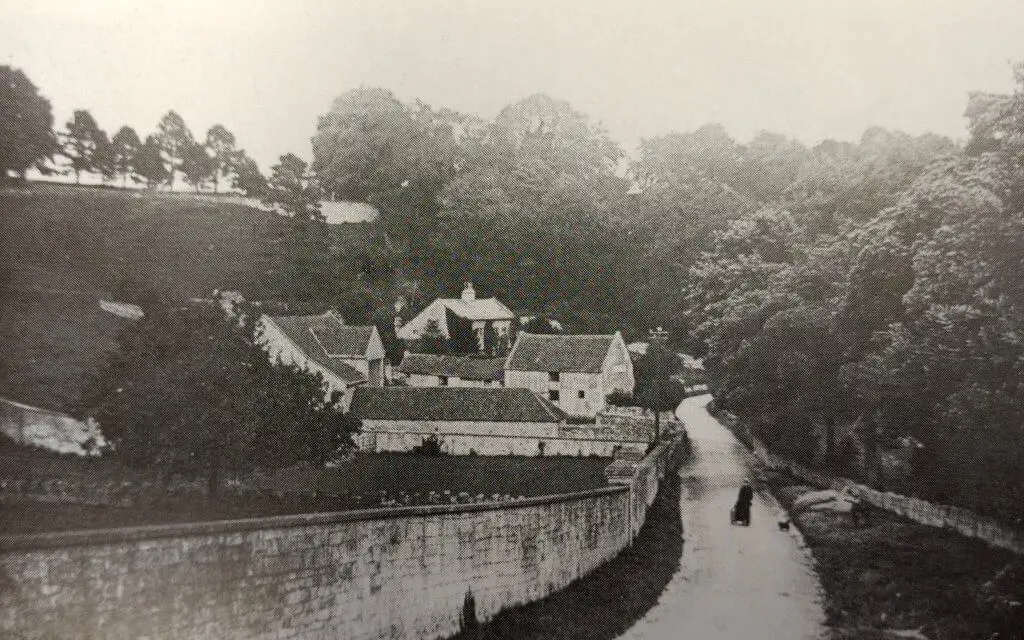
- 1 – 13 Quarry Vale Cottages, Combe Down, Bath, BA2 5JZ. List entry number: 1394534. Link to Pinterest. Early 19th century 2 storey rangework and ashlar quarry workers cottages.
-
De Montalt Wood, Combe Down, Bath, BA2 7EU. List entry number: 1395198. Link to Pinterest. 1848 Italianate villa set in grounds.
-
Chimney to West of De Montalt works. List entry number: 1395201. Lofty, tapered, ashlar shaft and boiler stack approximately 2.8m wide at base.
-
De Montalt Works (South Range), Summer Lane, Combe Down, Bath BA2 7EU. List entry number: 1395200. Early 19th century 2 storey ashlar range of workshops and stores.
-
De Montalt Works (Main East Block with aqueduct pylons), Summer Lane, Combe Down, Bath BA2 7EU. List entry number: 1395199. Link to Pinterest. Early 19th century printing works originally used to print notes for Bank of England, later converted to manufactory.
Combe Road
Combe Road area
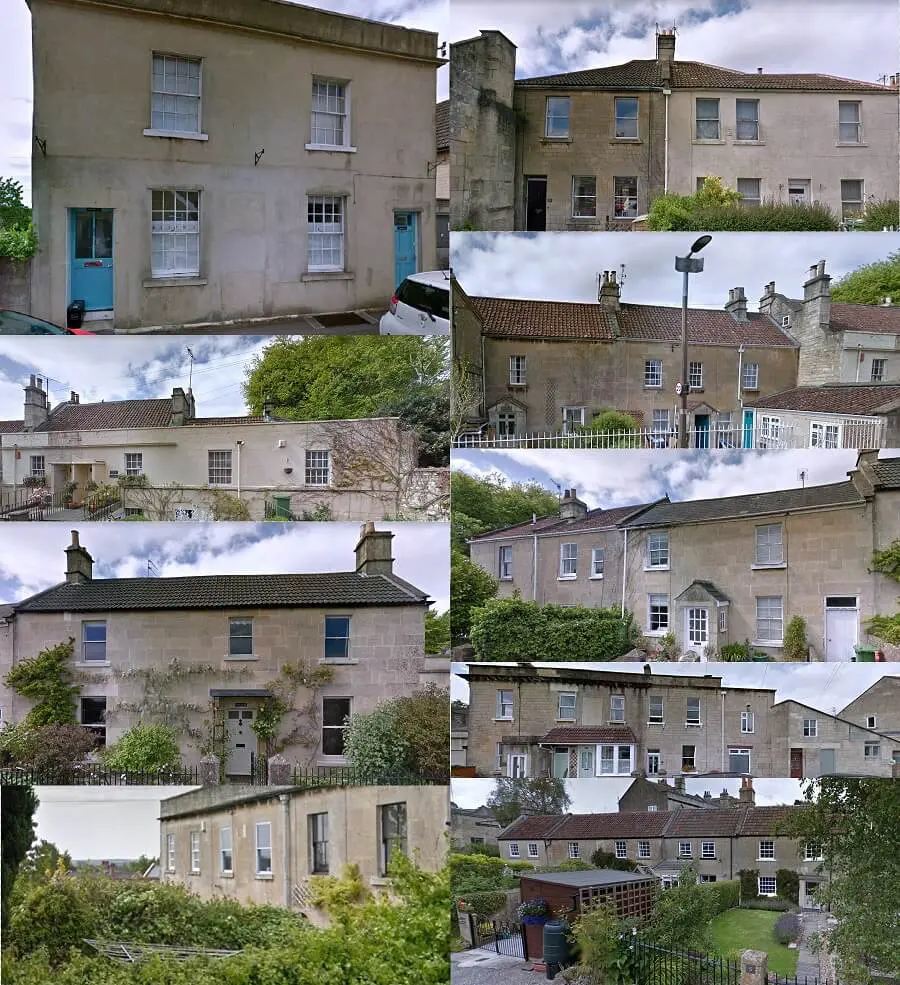
-
16 – 22 Combe Road, Combe Down, Bath, BA2 5HX, IoE number 445141. Link to Pinterest. (Delisted 2010). Early to mid 19th century 2 storey block of irregular coursed stone.
-
24 Combe Road, Combe Down,Bath, BA2 5HY. List entry number: 1394950. Link to Pinterest. c. 1830 2 storey double fronted ashlar house.
-
26 – 30 Combe Road, Combe Down, Bath, BA2 5HY. List entry number: 1394952. Link to Pinterest. c. 1830 block of 3, 2 storey ashlar cottages.
-
Beech Cottage, 32 Combe Road, Combe Down, Bath, BA2 5HY. List entry number: 1406246. Link to Pinterest. 1803, originally a pair of attached dwellings, probably built as workers’ cottages.
-
42 & 44 Combe Road, Combe Down, Bath, BA2 5HZ. List entry number: 1394954. Link to Pinterest. c. 1815 2 storey painted ashlar pair part of a row formerly known as Brunswick Place.
-
Boundary railings and gates to and 46 & 48 Combe Road, Combe Down, Bath BA2 5HY. List entry number: 1394960 and List entry number: 1394958. Link to Pinterest. c. 1815 or possibly refronting of slightly earlier 2 storey ashlar cottages. Part of a row formerly known as Brunswick Place.
-
50 & 52 Combe Road, Combe Down, Bath, BA2 5HY. List entry number: 1394963. Link to Pinterest. c. 1860-70 pair of plain 2 storey ashlar small houses.
-
King William IV, Combe Down, Bath, BA2 5HY. List entry number: 1394730. Link to Pinterest. c. 1830’s. 2 storey ashlar house.
-
Rock Hall House, Combe Down, Bath, BA2 5JF . List entry number: 1394731. Link to Pinterest. c. 1800 – 20 ashlar house extended late 19th century. Original house nearest to road of 2 storeys to rear, 3 storeys to main south front.
-
62 Combe Road, Combe Down, Bath, BA2 5HZ. List entry number: 1394964. Link to Pinterest. c. 1830 2 storey painted ashlar house.
-
1 – 3 Byfield Buildings, Combe Down, Bath, BA2 5JD. List entry number: 1395129. Link to Pinterest. c.1830 row of 2 storey small ashlar houses.
-
1 – 5 Byfield Place, Combe Down, Bath, BA2 5JD, List entry number: 1395131. Link to Pinterest. Early 19th century row of small 2 storey ashlar houses.
Bradford Road
Bradford Road area
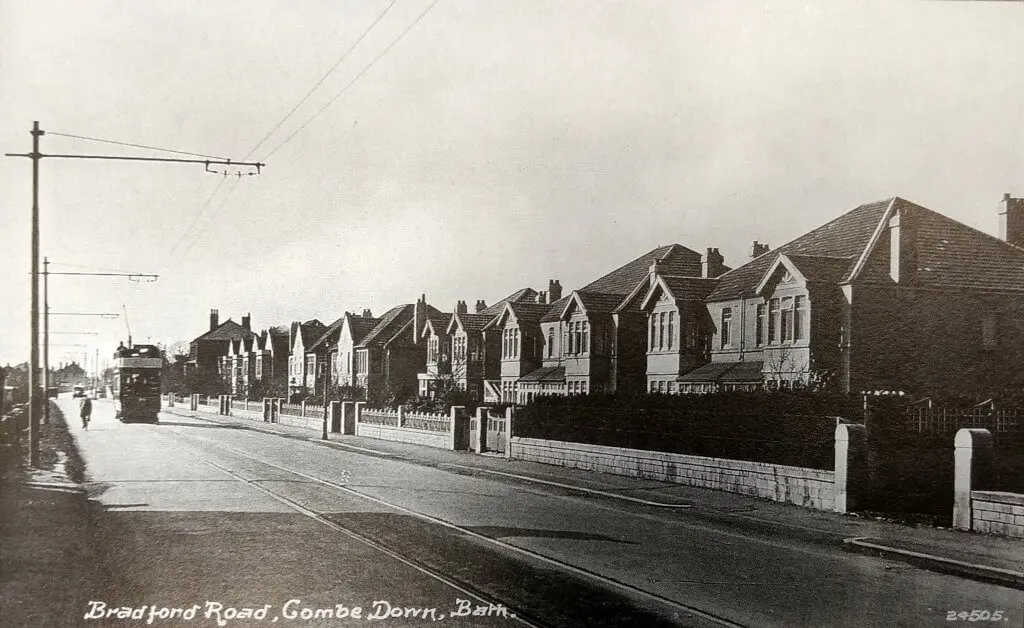
-
Parish boundary marker attached to 190 Bradford Rd, Combe Down, Bath BA2 5DA. List entry number: 1394949. Link to Pinterest. Cast-iron Turnpike Trust and parish boundary marker dated 1827.
-
Parish boundary marker 10m East of 199 Bradford Rd, Combe Down, Bath BA2 5BT. List entry number: 1394943. Late 18th century square stone block now defaced, marking an 18th century boundary, probably parish.
-
Jewish burial ground, walls and ohel, Greendown Place, Combe Down, Bath BA2 5DD. List entry number: 1396344. Link to Pinterest. Jewish Cemetery including walls, gates and Ohel (chapel), 1836, built of coursed rubble. The cemetery occupies a rectangular site running for approximately 30m East – West along Bradford Road and bounded by Greendown Place to the West and 174 Bradford Road to the East.
-
7 & 10 Greendown Place, Combe Down, Bath, BA2 5DD. List entry number: 1396342. Link to Pinterest. Early to mid 19th century ashlar houses in irregular terrace.
-
Quarry Cottage, Greendown Place, Combe Down, Bath, BA2 5DD. List entry number: 1396347. Link to Pinterest. Early 19th century ashlar or dressed stone house.
-
162 – 170 Greendown Terrace, Combe Down, Bath, BA2 5BZ, List entry number: 1394945. Link to Pinterest. Five ashlar terrace houses c. 1840.
Entry Hill
Entry Hill area

- Bladud, 54 Entry Hill, Combe Down, Bath, BA2 5LU. List entry number: 1395436. Ashlar detached villa, incorporating former farmhouse, 17th century and late 19th century.
-
Wildacre, 58 Entry Hill, Combe Down, Bath, BA2 5NA. List entry number: 1395732. Pair of ashlar houses, late 18th century or early 19th century with 20th century alterations.
-
64 – 72 Entry Hill, Combe Down, Bath, BA2 5LX. List entry number: 1395733. Early to mid 19th century coursed, squared, limestone rubble houses.
-
112 Entry Hill, Combe Down, Bath, BA2 5LS. List entry number: 1395736. Coursed, squared, limestone rubble house, probably 18th century, altered in 19th century.
-
Cross Keys Inn, 151 Midford Rd, Combe Down, Bath BA2 5RZ. List entry number: 1395715. Link to Pinterest. Inn of squared and coursed rubble with ashlar dressings, late 17th century or early 18th century origins, but much modified in mid to late 19th century.
-
Three boundary markers, Southstoke Road, Combe Down. List entry number: 1395000. Unusual group of three boundary marks at one spot, at south end of Southstoke Road immediately opposite Cross Keys Inn, dated 1827 and 1912, stone marker mid 19th century.
-
Three boundary posts, Southstoke Lane, Combe Down, List entry number: 1232500. 3 boundary posts dated 1827 for the Bath Turnpike Trust cast iron post, dated 1912 for cast iron triangular post with half pyramidal top and ashlar boundary post with semi-circular head, probably dated 1804.
-
Valley Spring, Southstoke Road, Combe Down, Bath, BA2 5SP. List entry number: 1401001. Link to Pinterest. A modernist house designed by the nationally important architect Peter Womersley, built for his brother John (managing director of Bath Cabinet Makers) in 1968, the house consists of three flat-roofed pavilions with plate glass walls set between tall red brick towers in Flemish bond.
Perrymead
Perrymead area
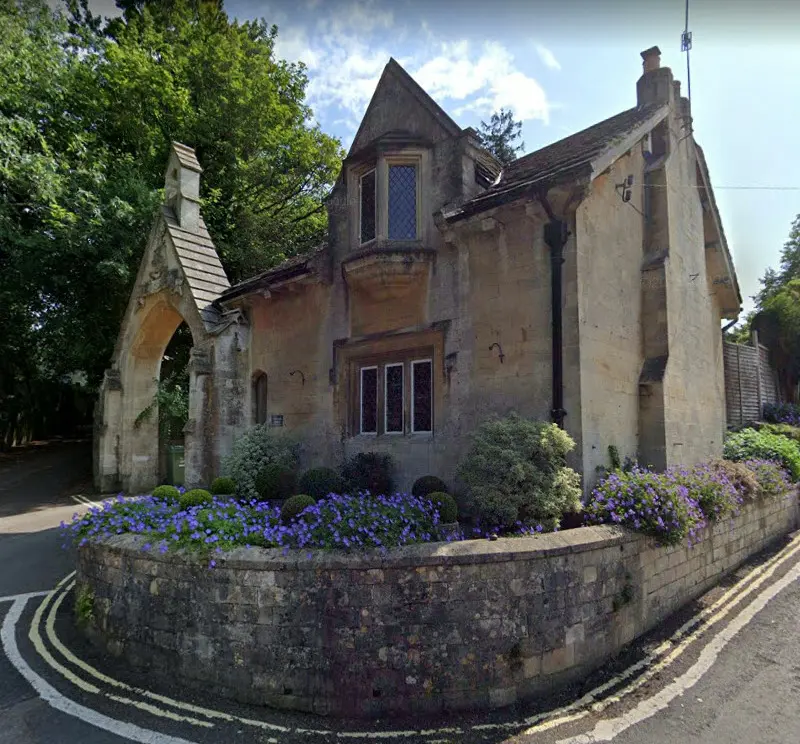
-
The Cloisters, Southside and North side, Perrymead, Bath, BA2 5AY. List Entry Number: 1394352. Detached house, now three houses. Early and late C19 with C20 alterations.
-
Cloisters Cottage, Perrymead, Bath, BA2 5AY. List Entry Number: 1394354. Detached house, former stable wing. Early C19 with C20 alterations.
-
Lodge and Archway to the Cloisters, Perrymead, Bath BA2 5AY. List Entry Number: 1394355. Lodge with attached gateway. Early and late C19.
-
Woodbine Cottage, Perrymead, Bath BA2 5AY. List Entry Number: 1394356. Detached house. Late C18, with late C19 and C20 alterations.
-
Hill Crest, Perrymead Lodge and Perrymead Court, Perrymead, Bath, BA2 5AZ. List Entry Number: 1394357. Group of three linked houses. Early and mid C19.
-
Moregrove and Little Moregrove, Perrymead, Bath, BA2 5AZ. List Entry Number: 1394359. Large detached house in two occupations. Early to mid C19 with C20 alterations.
-
1, 2, 3 Perrymead Place, Perrymead, Bath, BA2 5BB. List Entry Number: 1394363. House, in three apartments, attached to and formerly part of Perrymead House (qv). Mid C19.
-
Perrymead House, Perrymead, Bath, BA2 5BB. List Entry Number: 1394361. Villa, originally detached, now with attached Nos 1,2 and 3, Perrymead Court (qv). Early C19.
-
Middle Hill or Rock Lodge, Ralph Allen Drive, Bath, BA2 5AF. List Entry Number: 1394611. Lodge. c1830 with C20 additions. Probably by H.E. Goodridge.
-
Lower Lodge, Ralph Allen Drive, Bath, BA2 5AJ. List Entry Number: 1394612. Entrance lodge to Prior Park. c1740 by John Wood the Elder.
Midford Castle
Midford Castle area
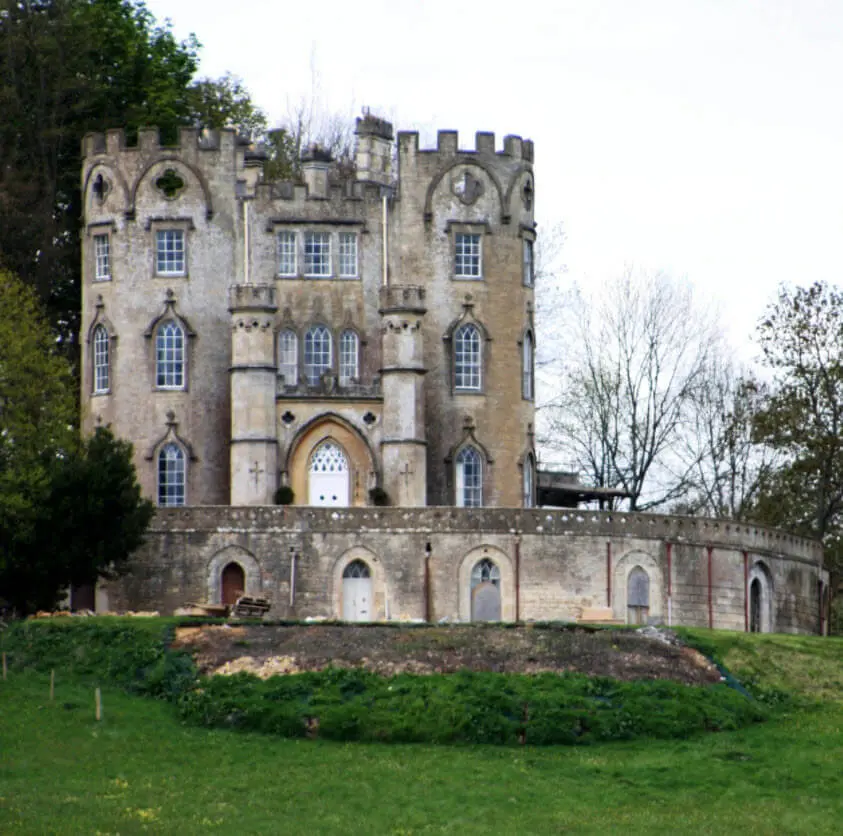
-
Milestone on Midford Road. List entry number: 1277078. Link to Pinterest. Square ashlar upright milestone, probably early 19th century, for the Bath Turnpike Trust.
-
Archway and lodge with screen wall, to Midford Castle. List entry number: 1232450. Link to Pinterest. Ashlar Gothic style archway and lodge concealed behind embattled parapets c. 1810.
-
Pair of gate piers and gates 50 yards North West of Midford Castle. List entry number: 1232488. Pair of gate piers, probably c. 1810 as a gateway on the drive between the Lodge and Midford Castle.
-
The stables, the old Chapel and the remains of the Chapel, walls enclosing stable yard, coach house and greenhouse to Midford Castle. List entry number: 1277080. Link to Pinterest. Gothick style stables, coach-house, chapel, stableyard and greenhouse; now 2 cottages (The Stables and The Old Chapel) with adjacent remains of the chapel, the converted coach-house and the greenhouse, c. 1810 for the Conolly family of Midford Castle.
-
Midford Castle with former offices and coach houses. List entry number: 1277079. Link to Pinterest. Small country house standing on and surrounded by its offices and coach-houses; the latter are now part of the house. c. 1775 for Henry Woolhouse Disney Roebuck, after designs by John Carter; porch added c. 1810 for Conolly family.
-
The Priory, in Priory Wood, 500 yards to North East of Midford Castle. List entry number: 1232452. Link to Pinterest. Gothick style summer house or tea-room in a ruined state; c. 1775, possibly to the design of John Carter.
Tucking Mill
Tucking Mill area
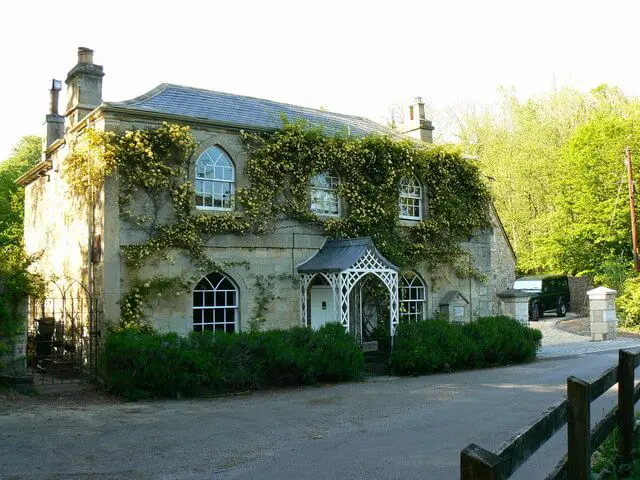
-
Tucking Mill Cottage. List entry number: 1232501. Link to Pinterest. Late 18th century ashlar house.
-
Tucking Mill House. List entry number: 1288240. Link to Pinterest. Late 18th century ashlar house altered in 19th century; home of William Smith, the father of British geology, who lived here whilst engaged in the construction of the Somerset Coal Canal.
Monkton Combe
Monkton Combe area
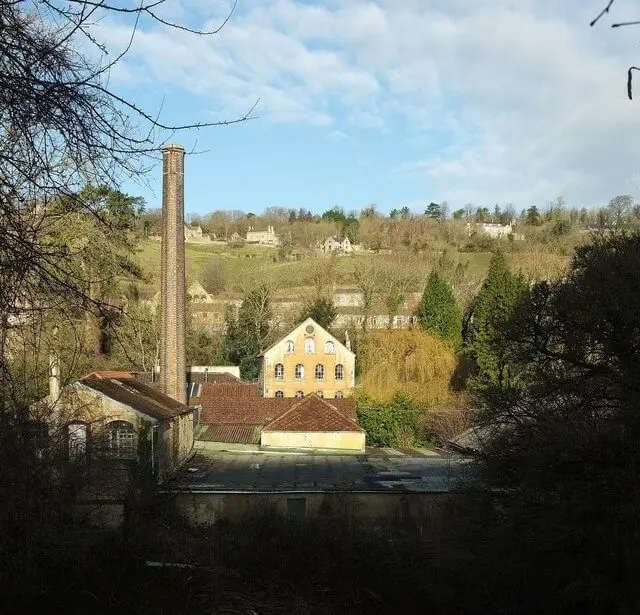
-
Dovecote, 60 yards to South West of Church farmhouse, Monkton Combe. List entry number: 1288194. Link to Pinterest. Dovecote, probably late 16th century of coursed rubble with squared ashlar blocks.
-
Barn to North of Church farmhouse Monkton Combe. List entry number: 1215227. Link to Pinterest. Early to mid 19th century coursed squared rubble and ashlar barn.
-
Church Farm, Church Lane, Monkton Combe, Bath BA2 7EX. List entry number: 1215226. Late 17th century to early 18th century coursed squared rubble with freestone dressing farm house.
-
Monks’ Retreat, Church Lane, Monkton Combe, Bath BA2 7EX. List entry Number: 1288193. Link to Pinterest. 16th century rubble with freestone dressing house, altered since, possibly a priest’s house, and later a farmhouse.
-
Monument to Margaretta Shute, in Churchyard to North of St Michael’s Church, Monkton Combe. List entry number: 1215198. Link to Pinterest. Ashlar chest tomb to Margaretta Shute, died 1812.
-
3 unidentified monuments, in churchyard and 2 yards South of West end, 3 yards South and 6 yards South of St Michael’s Church, Monkton Combe. List entry number: 1215200 and List entry number: 1215224 and List entry number: 1215225. Link to Pinterest. 3 ashlar chest tombs.
-
Group of 3 unidentified monuments, in churchyard to South East of St Michael’s Church, Monkton Combe. List entry number: 1288220. Link to Pinterest. Group of 3 early to mid 18th century ashlar chest tombs.
-
St Michael’s Church, Church Lane, Monkton Combe, BA2 7EZ. List entry Number: 1288219. Link to Pinterest. Anglican parish church with tower, nave, chancel, South aisle and chapel, North aisle and chapel in an Early English style, built in 1865 by C E Giles of Taunton, replacing a church of 1814; altered and enlarged 1886 by E H L Barker.
-
1 St Michael’s Court, Monkton Combe, Bath, BA2 7HA. List entry number: 1288264. Link to Pinterest. Early 18th century rubble with freestone dressing cottage.
-
2 St Michael’s Court, Monkton Combe, Bath, BA2 7HA. List entry number: 1215120. Link to Pinterest. Late 17th century rubble with freestone dressing cottage.
-
The Wheelwright’s Arms, Church Lane, Monkton Combe, Bath BA2 7HB. List entry number: 1215197. Link to Pinterest. Mid to late 18th century ashlar house, now a public house.
-
1 – 3 Julian Cottages, Church Lane, Monkton Combe, Bath BA2 7HF. List entry number: 1215196. Link to Pinterest. Early to mid 19th century row of 3 three storey ashlar cottages, now part of Monkton Combe School.
-
Lock Up, Mill Lane, Monkton Combe. List entry number: 1288263. Link to Pinterest. Lock up probably c. 1776. Ashlar, square plan with a plinth at the rear and domical stone roof. Narrow square headed door opening; plank door with barred peep hole. No windows.
-
The Old Mill, Mill Lane, Monkton Combe, Bath BA2 7HD. List entry number: 1215119. Link to Pinterest. Early to mid 18th century ashlar and coursed squared rubble mill, offices and carriage house, now a house.
-
Monkton Combe School (the part of the terrace block known as The Old Vicarage). List entry number: 1215195. Link to Pinterest. Early 19th century 3 storey ashlar vicarage, now part of a school.
-
Monkton Combe School (the main or old block known as the Old Farm). List entry number: 1215228. Link to Pinterest. Coursed squared rubble with freestone dressing farmhouse dated 1714, now part of school.
Brassknocker Hill
Brassknocker Hill area
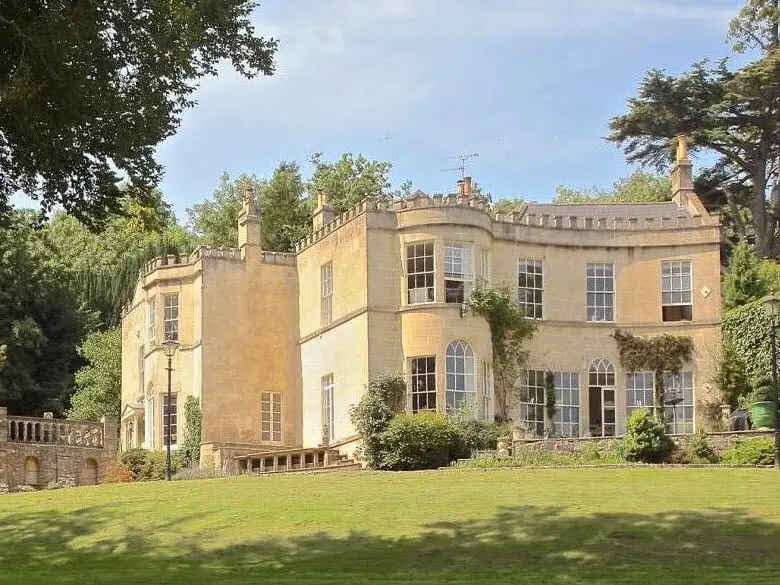
-
Gateway and adjoining mounting block in garden wall to South West of Combe Hill House. List entry number: 1288262. Link to Pinterest. c. 1790 rusticated gateway with sharply pointed 4 centred head, imposts and moulded cornice. Flanking rubble walls ramped down for approximately 1 yard to either side. By the South pier is a mounting block of 4 steps.
-
Combe Hill House, Brassknocker Hill, Bath BA2 7HU. List entry number: 1215116. Link to Pinterest. Late 18th century ashlar Gothick country villa with slate roofs concealed behind an embattled parapet.
-
Combe Grove Lodge, Brassknocker Hill, Bath BA2 7HU. List entry number: 1215117. Link to Pinterest. Ashlar lodge mid 18th century, extended late 18th century.
-
Quadrant walls, pair of gate piers and gates to East of Combe Grove Lodge. List entry number: 1215118. Link to Pinterest. Late 18th century and mid 19th century.
-
1, 2 and 3 Brassknocker Hill Cottages, Brassknocker Hill, Bath BA2 7HU. List entry number: 1288261. Link to Pinterest. Row of 3 coursed, squared rubble with freestone dressing cottages, 1 and 2 are early 18th century and 3 late 18th century. Originally a single property and Inn.
-
Boundary post on Brassknocker Hill. List entry number: 1215115. Link to Pinterest. Cast iron boundary post, triangular on plan with half hexagonal top, dated 1827 for Bath Turnpike Trust.
Combe Grove Manor
Combe Grove Manor area
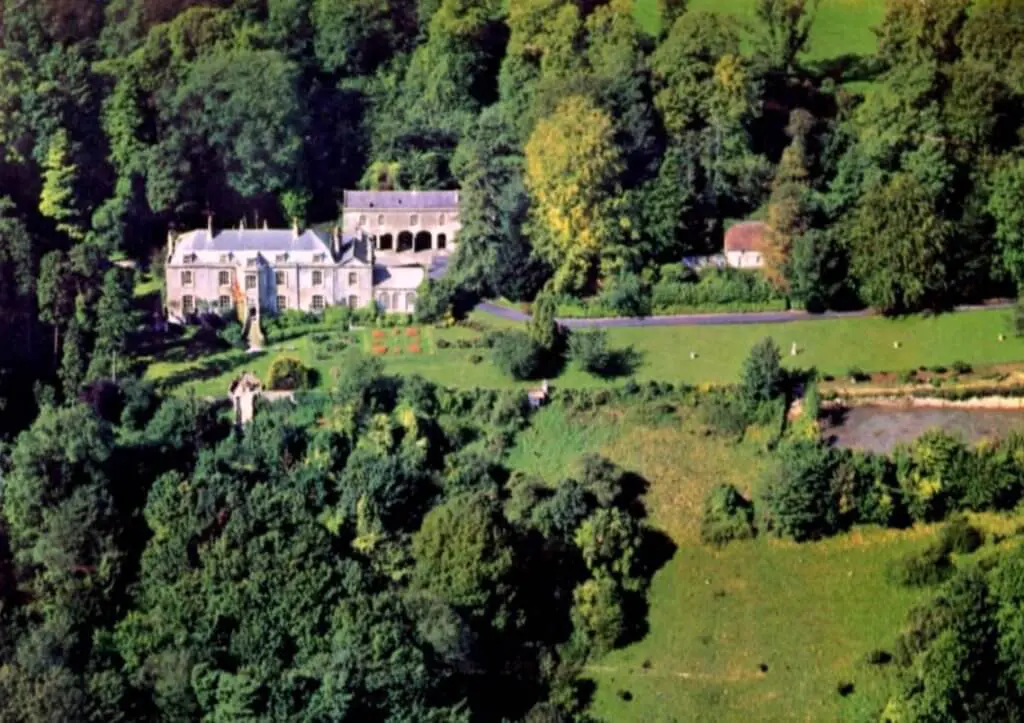
-
Rustic archway on drive to Combe Grove Manor. List entry number: 1288238. Link to Pinterest. Late 18th century – early 19th century rubble and rock faced rubble archway approximately 15 feet high.
-
Archway on drive to Combe Grove Manor. List entry number: 1215153. Link to Pinterest. Ashlar arch with imposts, flanked by plain pilasters and with pierced plain pierced parapet, dated 1858.
-
Walls, four pairs of gate piers and gates, fountain and 2 flights of steps surrounding garden to South of Combe Grove Manor. List entry number: 1215152. Link to Pinterest. Walls, gates, gate piers, 2 flights of steps and fountain, surrounding garden to south of Combe Grove Manor, probably mid 19th century.
-
Former coach house and coachman’s house to North of Combe Grove Manor. List entry number: 1288237. Link to Pinterest. Early 19th century ashlar 2 storey coach house and coachman’s house.
-
Combe Grove Manor, Brassknocker Hill, Bath, BA2 7HS. List entry number: 1215151. Link to Pinterest. Early 18th century ashlar country house of 2 storeys, basement and attics, now an hotel, altered c. 1858 for Vaughan Jenkins family.
Shaft Road
Shaft Road area
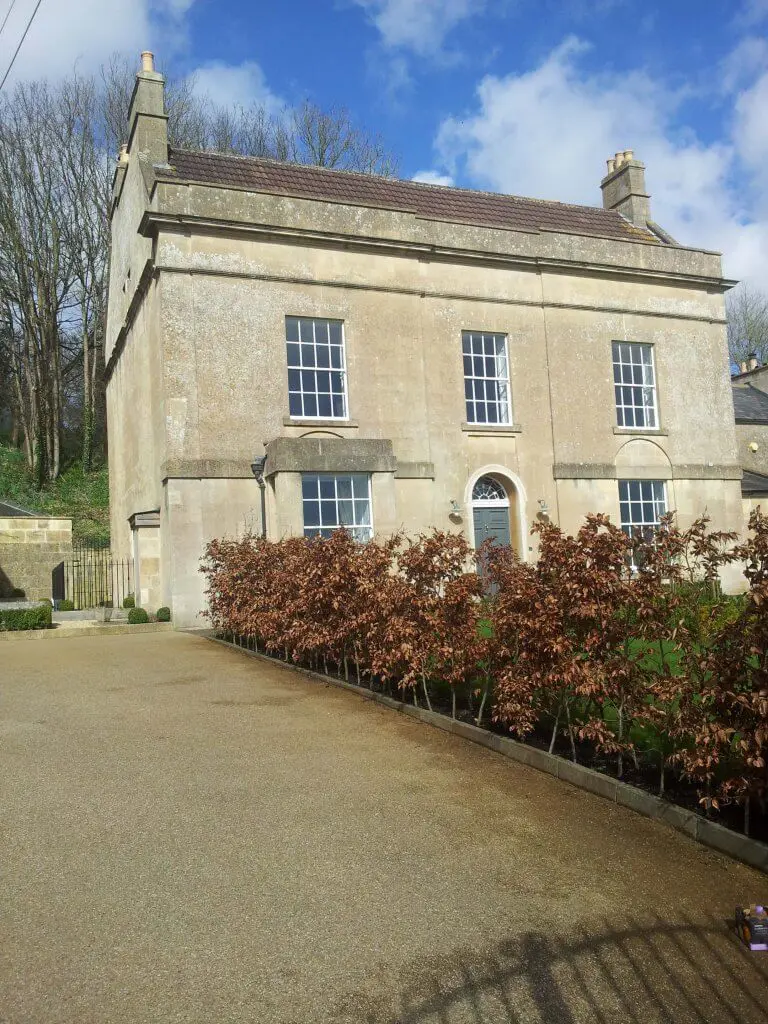
-
Ivy Cottages and front boundary wall, 1 and 2, Shaft Road, Bath BA2 7HL. List entry number: 1215156. Link to Pinterest. Late 17th century rubble with freestone dressing farmhouse, now a pair of cottages.
-
Combe Grange, Shaft Road, Bath BA2 7HL. List entry number: 1215155. Link to Pinterest. Early 19th century detached ashlar house with 2 storeys and basement.
-
The Old Farmhouse, Shaft Road, Bath BA2 7HL. List entry number: 1215154. Early 19th century detached ashlar house with 2 storeys.
-
Lodge Style, Shaft Road, Combe Down, Bath, BA2 7HP. List entry number: 1394909. Link to Pinterest. Detached ashlar house,1909, by Charles Voysey.
N.B. You can do a ‘map search’ at Historic England for any listed building.

